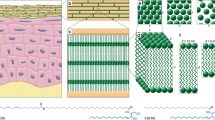Summary
In order to further clarify the role of intercellular lipids in the water-retention properties of the stratum corneum, forearm skin of six healthy male volunteers was treated with 5% sodium dodecyl sulfate (SDS) for 1, 10, and 30 min. All treatment periods induced chapping and scaling of the stratum corneum without any inflammatory reaction, accompanied by a significant decrease in its water-retention function. Electron-microscopic analysis of SDS-treated stratum corneum revealed selective depletion of the lipids from the intercellular spaces, accompanied by marked disruption of multiple lamellae structures. Lipid analysis also showed a considerable and selective loss of intercellular lipids such as cholesterol, cholesterol ester, free fatty acid, and sphingolipids. To evaluate the recovery potential for intercellular lipids, lipids which were separated as sebaceous-rich lipids (SLs) and stratum corneum lipids (SCLs) wer applied daily on SDS-treated forearm skin. Two daily applications of the SCLs which were emulsified at 10% concentration in W/O (water in oil) cream caused a significant increase in conductance, accompanied by a definite improvement in the level of scaling over no application or W/O emulsion base only, whereas SLs in the W/O emulsion base led to no significant recovery in either conductance value or scaling. When two daily topical applications of four chromatographically separated lipid fractions (cholesterol ester, free fatty acid, cholesterol, and sphingolipid) from the SCL were carried out at 1% concentration in the same system, the cholesterol ester and sphingolipid fractions were found to induce a significant increase in the conductance value over no application. In contrast, the free fatty acid and cholesterol fractions showed no significant increase in conductance value. Similarly, the scaling which occurred after SDS treatment had a tendency to decrease after the two daily applications with the fractions of cholesterol ester, sphingolipids, and free fatty acid as compared with that of the base emulsion. These findings strongly suggest that sphingolipids, possibly in combination with other neutral lipids, play an essential role in the establishment or maintenance of water-retention capacity in the stratum corneum.
Similar content being viewed by others
References
Akasaki S, Minematsu Y, Yoshizuka N, Imokawa G (1988) A role of intercellular lipids in the water-holding properties of the stratum corneum: recovery effect on experimentally induced dry skin. Jpn J Dermatol 98:41–51
Elias PM (1981) Epidermal lipids, membranes and keratinization. Int J Dermatol 20:1–19
Elias PM (1981) Lipids and the epidermal permeability barrier. Arch Dermatol Res 270:95–117
Elias PM (1983) Epidermal lipids, barrier function, and desquamation. J Invest Dermatol 80:44s-49s
Elias PM, Brown BE (1978) The mammalian barrier layer: defective barrier function in essential fatty acid deficiency correlates with abnormal intercellular lipid deposition. Lab Invest 39:574–583
Elias PM, Brown BE, Ziboh VA (1980) Permeability barrier in essential fatty acid deficiency: evidence for a direct role for linoleic acid in barrier function. J Invest Dermatol 74:230–239
Fulmer AW, Kramer GJ (1986) Stratum corneum lipid abnormalities in surfactant-induced dry scaly skin. J Invest Dermatol 86:598–602
Grayson S, Elias PM (1982) Isolation and lipid biochemical characterization of stratum corneum membrane complexes: implication for the cutaneous permeability barrier. J Invest Dermatol 78:128–135
Houtsmuller UMT (1982) Effects of topical applications of fatty acids in essential fatty acid deficiency. Prog Lipid Res 20:219–224
Imokawa G (1984) Evaluation for alteration of the stratum corneum. J Jpn Cosmet Sci Soc 8:92–108
Imokawa G, Hattori M (1985) A possible function of structural lipids in the water-holding properties of the stratum corneum. J Invest Dermatol 84:282–284
Imokawa G, Sumura K, Katsumi M (1975) Study on skin roughness caused by surfactants. I. A new method in vivo for evaluation of skin roughness. J Am Oil Chem Soc 8:92–108
Imokawa G, Akasaki S, Hattori M, Yoshizuka N (1986) Selective recovery of deranged water-holding properties by stratum corneum lipids. J Invest Dermatol 87:758–761
Kawai M, Yoshizuka N, Imokawa G, Okamoto K, Toda K (1983) Acrolein vapor fixation in electron microscopy of the horny layer. In: Seiji M, Bernstein IA (eds) Normal and abnormal epidermal differentiation. University of Tokyo Press, Tokyo, pp 207–214
Lampe MA, Burlingame AL, Whitney J, Williams ML, Brown BE, Roitman E, Elias PM (1983) Human stratum corneum lipids: characterization and regional variations. J Lipid Res 24:120–130
Long SA, Wertz JS, Strauss JS, Downing DT (1985) Human stratum corneum polar lipids and desquamation. Arch Dermatol 277:284–287
Lowe J, De Quoy PR (1978) Linoleic acid effects on DNA synthesis and cutaneous prostaglandin levels in essential fatty acid synthesis. J Invest Dermatol 70:200–203
Tagami H, Yoshikuni K (1985) Interrelationship between water-barrier and reservoir functions of pathologic stratum corneum. Arch Dermatol 121:642–645
Tagami H, Knamaru Y, Inoue K, Suehisa S, Inoue F, Iwatsuki K, Yoshikuni K, Yamada Y (1982) Water sorptiondesorption test of the skin in vitro for functional assessment of the stratum corneum. J Invest Dermatol 78:425–428
Wertz PW, Downing DT (1982) Glycolipids in mammalian epidermis: structure and function of the water barrier. Science 21:1261–1262
Wertz PW, Downing DT (1983) Ceramides of pig epidermis: structure determination. J Lipid Res 24:759–765
Wertz PW, Cho ES, Downing DT (1983) Effect of essential fatty acid deficiency on the epidermal sphingolipids of the rat. Biochim Biophys Acta 753:350–355
Wertz PW, Miethke MC, Long SA, Strauss JH, Downing DT (1985) Composition of the ceramides from human stratum corneum and from comedones. J Invest Dermatol 84:410–412
Wertz PW, Abraham W, Landmann L, Downing DT (1986) Preparation of liposomes from stratum corneum lipids. J Invest Dermatol 87:582–584
Author information
Authors and Affiliations
Rights and permissions
About this article
Cite this article
Imokawa, G., Akasaki, S., Minematsu, Y. et al. Importance of intercellular lipids in water-retention properties of the stratum corneum: induction and recovery study of surfactant dry skin. Arch Dermatol Res 281, 45–51 (1989). https://doi.org/10.1007/BF00424272
Received:
Issue Date:
DOI: https://doi.org/10.1007/BF00424272




